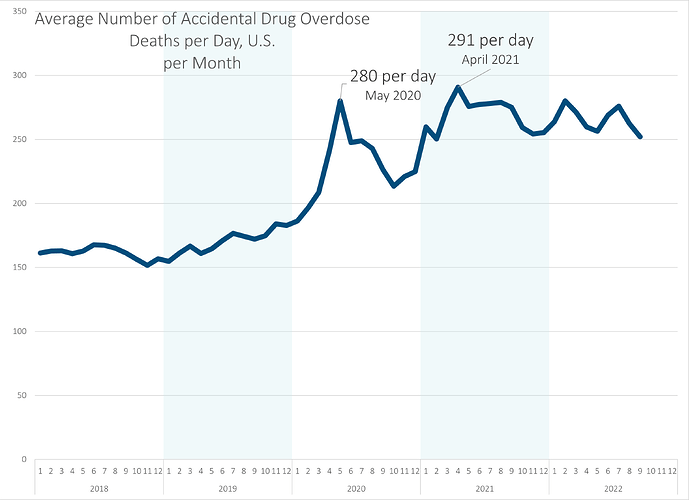Sure. They are materially higher than 2019 though.
This doesn’t bring your Covid deaths to 0.
Those numbers are just averages.
In the US, you have large variances from State to State in as far as being fully vaccinated is concerned (R states are low while D states are high). So naturally, covid is still killing a fair amount of people in the low vaxx states.
Thats not the case in the UK. When you have more fully vaccinated people and this element is also more geographically uniform throughout the country, the mortality numbers drop for covid deaths.
552 weekly deaths from Covid as at March 30th
Thats out of an average of 12,000 deaths/week (March)
So its about 4.6% of total deaths and a rate of about 8 per million (UK population wise).
How does that compare to the same period in 2019?
It also looks like the 552 / 4.6% is March 2023, and about half of March 2022… which I assume is the relevant March when you’re talking about 2022 deaths.
At some point “pandemic” becomes “endemic”.
If COVID just becomes part of a seasonal mix of disease that generally kills older people, as with our seasonal flu death spikes each winter (which sometimes is worse some years), then there ya go.
If the UK had a much lower COVID impact in 2022 than the US did, well, then it was a “non-pandemic” year, as 2023 is shaping up for the US.
Sure, but it’s going to continue to impact mortality for years to come. And not just the people immediately dying of Covid (which continues to be a thing that happens), but also all the people who were weakened by it and then die from something else who would still be alive if they hadn’t caught Covid 2 years ago and been weakened from it.
TP’s post read like it was surprising that 2022 mortality is higher than pre-Covid.
So… I’m trying to figure out the myriad things going on. Not just “long COVID”, but other conditions that may have been undiagnosed or undertreated/untreated the last few years.
One of the trends I found concerning:
I don’t think that’s COVID. That’s untreated kidney disease.
Or Horse pills.
Well, let’s see – this is the category I’m pulling for kidney disease deaths - and here is the detail by sex and race/ethnicity (largest groups, I’m not showing the small ones).
From the groups with the worst rates:
Could be horse pills in some of these cases, but there are some different patterns going on here. If I broke it out by age group/state, we’d probably see other things, too.
There may be COVID complications, to be sure.
This is the query, if you want to look at the whole thing:
https://wonder.cdc.gov/controller/saved/D176/D336F083
(you may have to re-sort)
This thread is a lot funnier than what you’d expect from the title.
I don’t have the math chops to do what meeps’ doing, but it sure does look like fun. I could totally spend my day pulling data apart looking for patterns and drawing conclusions.
…and then getting interviewed by the BBC
[watch this space]
Just to expand on this.
There is no surprise that covid & flu are still killing the older folks.
The main finding in 2022 is that older folks are dying faster due to non-covid related reasons.
These reasons are driven by a lack of access to timely healthcare. For example, if you are an older person that has chronic condition(s) that had been stable before covid, primarily due to having access to timely public healthcare in the NHS, what we see now in the UK is that those same chronic conditions are causing accelerated deaths due to lack of available timely healthcare (in essence the chronic conditions deteriorate causing death).
At the population level this tends to impact poorer regions more vs wealthier regions in the UK because wealthier people can be seen privately, so there is no need for them to wait for public healthcare in the NHS.
Essentially, the CMI working group concluded that this is our “new normal” in the UK. More people will be dying earlier than previously expected due to healthcare availability constraints.
Thanks!
Sure, that part makes sense. But it’s not like Covid is done impacting mortality. Even sone of the deaths that aren’t directly due to Covid are probably indirectly due to Covid. The person was weakened by Covid and then succumbed to something else that wouldn’t have killed then had they not been weakened first from Covid. Or the person’s care was reduced due to Covid lockdowns and then that resulted in complications. Or people have left the medical field due to Covid burnout thus reducing capacity for care.
Directly or indirectly, a lot of those excess deaths are still Covid-related.
Yup.
Just not going to be easily estimated.
So now the categories are “from”, “with”, and “adjacent to” on the death certs?
There are/were areas and doctors that rigorously avoided mentioning COVID on death certs. Other than via large-number analysis, we’ll never know about those.
We definitely know the total number of deaths. Those are very difficult to hide.
That’s why I always started with that in my analysis, starting from 2020. The deaths have to be allocated somewhere.









